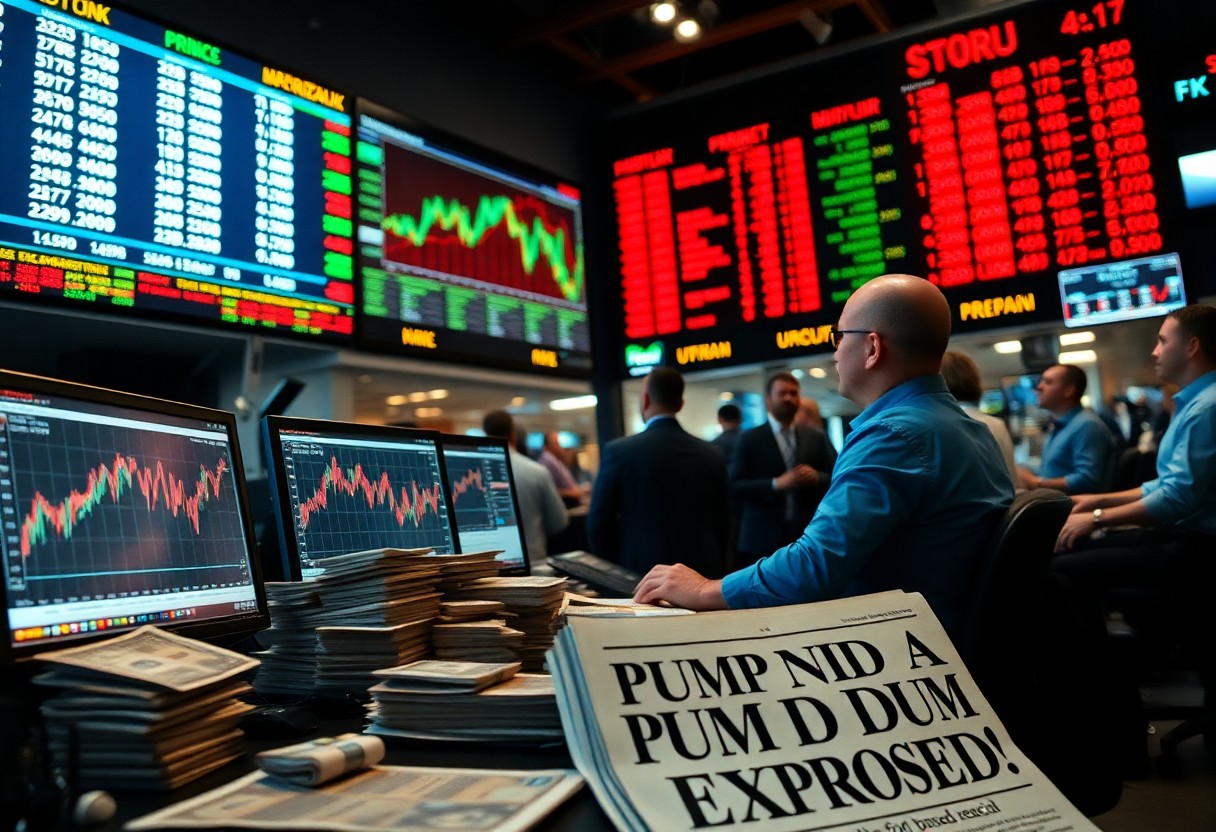What Are the Signs of a Pump-and-Dump Scheme?
It’s vital to recognize the signs of a pump-and-dump scheme to protect your investments. Typically, these schemes involve the intentional inflating of a stock’s price through misleading information, encouraging you to invest before it’s “dumped” by the schemers. Look for unusual trading volumes, aggressive promotion on social media, and rapid price spikes followed by steep drops. By being aware of these indicators, you can safeguard your portfolio from potential losses associated with these fraudulent activities.
Understanding Pump-and-Dump Schemes
A pump-and-dump scheme is a type of securities fraud that involves artificially inflating the price of a stock to profit from selling it at the high point. Typically orchestrated by individuals or groups through misleading information, this unethical practice ultimately leads to severe losses for unsuspecting investors once the orchestrators sell their shares, leaving others holding worthless stocks.
Definition of Pump-and-Dump
With a pump-and-dump scheme, fraudsters manipulate the price of a stock through false or exaggerated claims to create buying momentum. Once the price peaks due to panic-buying, the schemers sell their shares for profit, leaving other investors with significant losses.
Historical Context and Examples
Between the late 1990s and early 2000s, numerous pump-and-dump schemes exploited nascent technologies and the internet, leading to significant investor losses. Online promotion of stocks, often through mailing lists and chat rooms, enabled the rapid spread of false information. One infamous case involved “dot-com” companies, where hype drove stock prices up before they crashed, costing investors significantly. Your awareness of these past schemes can help you identify similar trends today.
The rise of social media and online trading platforms has made pump-and-dump schemes even more prevalent and accessible. The GameStop phenomenon in early 2021 showcases how coordinated groups can drive prices to unsustainable highs, leading to significant fallout for many retail investors. Understanding these historical cases equips you with the tools to spot red flags and protect your investments from similar schemes in the future.
Common Signs of a Pump-and-Dump Scheme
Some of the most notable signs of a pump-and-dump scheme include rapid price surges, excessive trading volume, and unusual marketing tactics. You may find companies promoting their stock aggressively, often through social media or online forums, which can create an artificial hype around the stock. Being aware of these indicators can help you navigate investments more safely.
Unusually High Trading Volume
The presence of unusually high trading volume often signifies a pump-and-dump scheme. When you notice a significant spike in trading activity, especially if it contrasts sharply with previous patterns, it suggests that something manipulative might be occurring. You should investigate whether the volume is linked to legitimate business developments or merely speculative trading drives.
Sudden Price Increases
Around the time of a pump-and-dump scheme, you may observe dramatic price increases that appear disconnected from the company’s actual performance. Such spikes can lure you into investing, believing in sustained growth. However, these gains are often short-lived and built on speculative hype rather than value; as a result, you might find yourself left with significant losses when the price inevitably collapses.
At this stage, it’s imperative to be cautious. The initial surge in price can feel tempting as you watch potential profits rise rapidly. However, this is usually driven by manipulation rather than genuine interest in the company. You should remain vigilant and consider whether the gains are based on sound fundamentals or if it’s merely a fleeting opportunity fueled by hype before the stock naturally reverts, leaving you with potential losses.
Characteristics of the Promoters
While the individuals behind pump-and-dump schemes often appear charming, they typically possess certain traits that raise red flags. These promoters are often experienced in manipulating market perceptions and have a clear agenda to profit from your investments. Their main objective is to inflate stock prices falsely, often leading you to believe in unrealistic growth potential.
Anonymous or Fake Identities
Among the most alarming signs of fraudulent promoters is their use of anonymous or fake identities. They may operate under pseudonyms or through ghost accounts, making it difficult for you to verify their credibility and past actions. This lack of transparency can indicate that they are attempting to hide their true intentions.
Aggressive Marketing Tactics
By employing aggressive marketing tactics, promoters aim to capture your attention and encourage impulsive buying decisions. They often use hype-filled newsletters, social media posts, and misleading claims to create a buzz around a stock, pushing you toward investing without proper research.
Hence, recognizing aggressive marketing tactics is vital. These promoters will often leverage sensational claims, exaggerated testimonials, and high-pressure sales techniques to entice you. They create a sense of urgency, making you feel that you must act quickly to secure your profits. By being aware of these tactics, you can better protect yourself from falling victim to schemes that prioritize their profit over your financial well-being.
Social Media and Online Influence
To navigate the landscape of pump-and-dump schemes, you must be aware of how social media amplifies these deceptive tactics. Unscrupulous individuals leverage platforms to disseminate misleading information, creating a false sense of urgency and excitement around specific stocks, which may lead you to make impulsive investment decisions.
Role of Social Media in Promotion
Among the most effective tools for promoting pump-and-dump schemes, social media enables rapid spread of information, often targeting inexperienced investors. Posts and advertisements may showcase inflated stock prices and testimonials that distort reality, making it crucial for you to approach such claims with skepticism.
Identifying Fraudulent Communication
Role in distinguishing between legitimate and fraudulent communication cannot be understated. You should be on the lookout for vague language, exaggerated claims, or promises of high returns with low risk—common indicators of deception. Transparency about the source and evidence provided backing the information can help in assessing its authenticity.
Plus, analyze the source of information you encounter on social media. If a post seems too good to be true, it likely is. Watch for unverified endorsements, emotional language, and a lack of credible references. These red flags often signal a pump-and-dump scheme aimed at exploiting your trust and enthusiasm. By recognizing these signs, you can protect your investments from potential fraud.
Regulatory Actions and Legal Consequences
For those involved in pump-and-dump schemes, awareness of the potential regulatory actions and legal consequences is vital. Regulatory bodies like the SEC actively monitor trading activities and impose severe penalties on fraudulent practices, emphasizing the seriousness of such schemes. Engaging in or promoting these activities can lead to criminal charges, civil penalties, and significant damage to your financial reputation.
Overview of Regulations
Among the various regulations in place to combat fraud, the Securities Act of 1933 and the Securities Exchange Act of 1934 serve as foundational laws aimed at ensuring transparency and protecting investors. These regulations impose strict disclosure requirements and prohibit manipulative practices, holding individuals accountable for misleading information that can distort market integrity.
Penalties for Perpetrators
About individuals implicated in pump-and-dump schemes, the penalties can include hefty fines and possible prison sentences. The SEC may impose civil penalties that can reach millions of dollars, while criminal charges may lead to significant time behind bars.
Consequences of engaging in such activities are severe. Violators could face fines that may exceed $1 million and prison sentences of up to 20 years. Additionally, your professional reputation will suffer irreparable damage, making it difficult to pursue future opportunities in finance. Understanding these risks is necessary to protect your interests and maintain integrity in your trading activities.
Protecting Yourself from Pump-and-Dump Schemes
Your best defense against pump-and-dump schemes lies in vigilance and education. By understanding how these schemes operate and staying informed about market trends, you can better protect your investments. Always scrutinize any stock recommendations and do not rush into investments based solely on hype or social media buzz. Diversifying your portfolio and setting clear financial goals will also help minimize risks.
Conducting Thorough Research
Between your investment decisions and potential profits lies the need for thorough research. Evaluate a company’s fundamentals, financial reports, and market position before investing. Check for credible sources of information and be wary of any inconsistent claims or overly enthusiastic endorsements that lack depth.
Recognizing Red Flags
Between blatant hype and misleading promotions, recognizing red flags is imperative. Look out for rapid stock price increases without corresponding earnings growth, overly aggressive marketing tactics, and promoters who lack credibility. Often, these signs indicate that a stock is being artificially inflated for a quick profit, suggesting you should proceed with caution.
Due to the deceptive nature of pump-and-dump schemes, it’s vital to stay alert for signs of orchestrated price manipulation. Watch for unregulated stock promotions that create a false sense of urgency, as well as overzealous endorsements by anonymous users on forums. The presence of massive volume spikes accompanied by a sudden price surge is another indication that something is amiss. Being aware of these red flags can help you avoid potential losses and make more informed investment choices.
Summing up
Conclusively, recognizing the signs of a pump-and-dump scheme is imperative for protecting your investments. Look for sudden spikes in stock prices accompanied by heavy promotional activity, often through social media or online forums. Be wary of stocks with low trading volume and the promise of guaranteed returns. If you notice the founders or insiders suddenly selling off their shares after a price surge, it’s a red flag. Staying informed and vigilant about these indicators can help you avoid potential financial losses.






